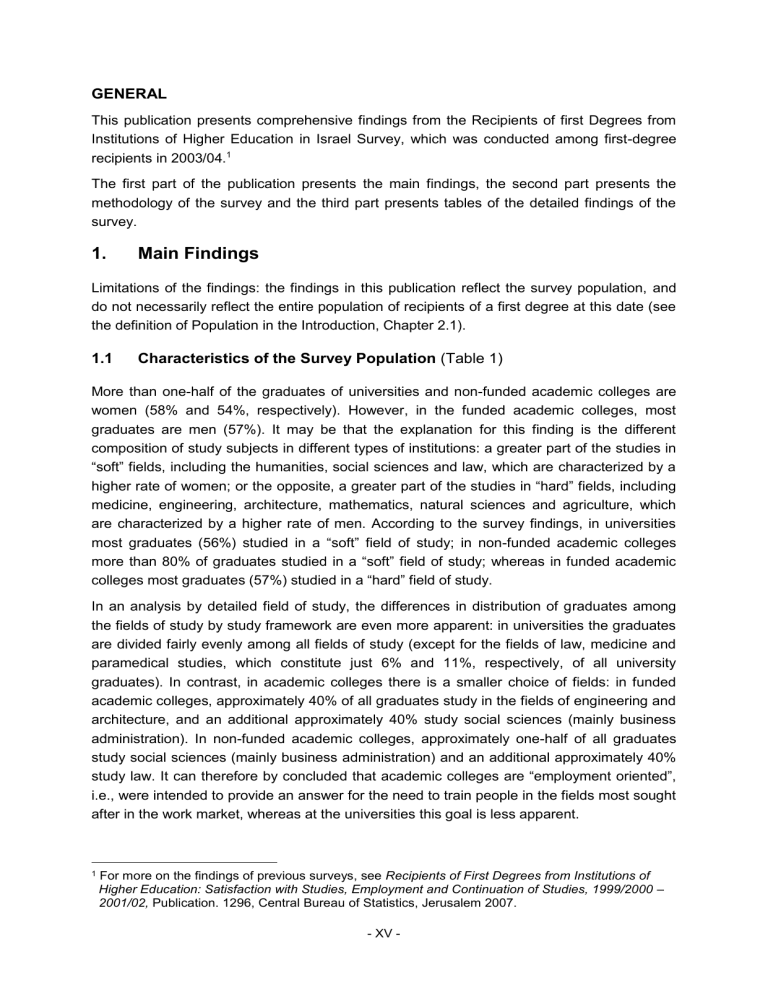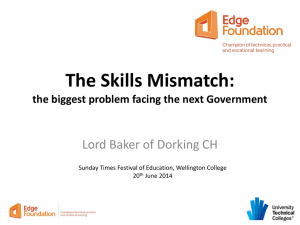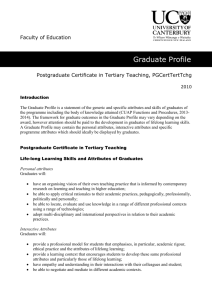2.7.2 Confidence interval of the estimate

GENERAL
This publication presents comprehensive findings from the Recipients of first Degrees from
Institutions of Higher Education in Israel Survey, which was conducted among first-degree recipients in 2003/04.
1
The first part of the publication presents the main findings, the second part presents the methodology of the survey and the third part presents tables of the detailed findings of the survey.
1. Main Findings
Limitations of the findings: the findings in this publication reflect the survey population, and do not necessarily reflect the entire population of recipients of a first degree at this date (see the definition of Population in the Introduction, Chapter 2.1).
1.1 Characteristics of the Survey Population
(Table 1)
More than one-half of the graduates of universities and non-funded academic colleges are women (58% and 54%, respectively). However, in the funded academic colleges, most graduates are men (57%). It may be that the explanation for this finding is the different composition of study subjects in different types of institutions: a greater part of the studies in
“soft” fields, including the humanities, social sciences and law, which are characterized by a higher rate of women; or the opposite, a greater part of the studies in “hard” fields, including medicine, engineering, architecture, mathematics, natural sciences and agriculture, which are characterized by a higher rate of men. According to the survey findings, in universities most graduates (56%) studied in a “soft” field of study; in non-funded academic colleges more than 80% of graduates studied in a “soft” field of study; whereas in funded academic colleges most graduates (57%) studied in a “hard” field of study.
In an analysis by detailed field of study, the differences in distribution of graduates among the fields of study by study framework are even more apparent: in universities the graduates are divided fairly evenly among all fields of study (except for the fields of law, medicine and paramedical studies, which constitute just 6% and 11%, respectively, of all university graduates). In contrast, in academic colleges there is a smaller choice of fields: in funded academic colleges, approximately 40% of all graduates study in the fields of engineering and architecture, and an additional approximately 40% study social sciences (mainly business administration). In non-funded academic colleges, approximately one-half of all graduates study social sciences (mainly business administration) and an additional approximately 40% study law. It can the refore by concluded that academic colleges are “employment oriented”, i.e., were intended to provide an answer for the need to train people in the fields most sought after in the work market, whereas at the universities this goal is less apparent.
1 For more on the findings of previous surveys, see Recipients of First Degrees from Institutions of
Higher Education: Satisfaction with Studies, Employment and Continuation of Studies, 1999/2000 –
2001/02, Publication. 1296, Central Bureau of Statistics, Jerusalem 2007.
- XV -
UNIVERSITY GRADUATES, BY FIELDS OF STUDY
2003/04
40
30
20
10
0
10.7
18.8
14.8
Medicine and paramedical studies
Mathematics, natural sciences and agriculture
Engineering and architecture
“Hard fields” (Sciences and Engineering) -
44.3%
20.8
The
Humanities
28.6
Social sciences
6.3
Law
“Soft fields” (the Humanities and Social
Sciences) - 55.7%
50
40
30
20
10
0
GRADUATES OF COLLEGES FUNDED BY THE PLANNING AND
BUDGETING COMMITTEE OF THE COUNCIL FOR HIGHER
EDUCATION, BY FIELDS OF STUDY 2003/04
38.8
36.8
17.1
6.9
0.8
Medicine and paramedical studies
Mathematics, natural sciences and agriculture
Engineering and architecture
“Hard fields” (Sciences and Engineering) -
56.6%
The Humanities Social sciences
“Soft fields” (the Humanities and
Social Sciences) - 43.4%
GRADUATES OF NON-FUNDED COLLEGES, BY FIELDS OF STUDY
2003/04
60
50
40
30
20
10
0
12.5
1.5
Mathematics, natural sciences and agriculture
Engineering and architecture
“Hard fields” (Sciences and Engineering) -
14.0%
47.8
Social sciences
38.2
Law
“Soft fields” (the Humanities and Social
Sciences) - 86.0%
- XVI -
1.2 Satisfaction
(Tables 2-10 and 15)
General satisfaction with teaching and the teaching environment is higher among graduates from academic colleges (funded and non-funded) than among university graduates (approximately 90% of those who graduated from college in 2001/02-2003/04 were satisfied, compared with only approximately 78% of those who graduated from university during those years).
It was found that general satisfaction with teaching and the teaching environment was slightly higher among university graduates who studied the humanities and social sciences, compared with those who studied the sciences and engineering (approximately 80% compared with approximately 74%, respectively, are satisfied). Among funded academic colleges, too, the general satisfaction with teaching and the teaching environment was slightly higher in the humanities and social sciences than in the sciences and engineering
(93% compared with 84%, respectively). In non-funded academic colleges there was no clear difference found in the satisfaction of graduates of the humanities and social sciences compared with graduates of the sciences and engineering.
SATISFACTION WITH TEACHING AND THE TEACHING
ENVIRONMENT, BY FRAMEWORK AND FIELD OF STUDY
GRADUATES OF 2003/04
100
80
60
40
20
0
Universities Funded Colleges Non-Funded Colleges
The humanities and social sciences Sciences and engineering
A comparison of the survey among graduates of 2003/04 with the survey among graduates of 2001/02, resulted in the following findings: in the universities, there was no significant change in the percentage of satisfaction. However, in funded academic colleges, a rise occurred in the satisfaction of graduates in the fields of the humanities and social sciences
(from 87% to 93%), and concurrently, a drop occurred in the satisfaction of graduates of the sciences and engineering (from 89% to only 84%) (Table 2).
The findings on the subject of Satisfaction with lecturers are similar to the findings on the subject of satisfaction with teaching and the teaching environment: satisfaction with the lecturers is higher among graduates from academic colleges (funded and non-funded), than among graduates from universities; and among graduates in the humanities and social sciences than among graduates in the sciences and engineering (Table 4).
- XVII -
SATISFACTION WITH LECTURERS,
BY FRAMEWORK AND FIELD OF STUDY
GRADUATES OF 2003/04
50
40
30
20
10
0
Universities Funded Colleges Non-Funded Colleges
The humanities and social sciences Sciences and engineering
The findings regarding general satisfaction with Student Services show that the lowest level of satisfaction is among university graduates, in all fields of study, whereas the highest level of satisfaction is found among graduates of non-funded academic colleges (Table 5).
SATISFACTION WITH STUDENT SERVICES,
BY FRAMEWORK AND FIELD OF STUDY
GRADUATES OF 2003/04
90
80
70
60
50
40
30
20
10
0
Universities Funded Colleges
The humanities and social sciences
Non-Funded Colleges
Sciences and engineering Total
A comparison of detailed fields of study (with no distinction of types of study institutions) shows that in the fields of social sciences, law and medicine a distinct rise has occurred in the percentage of satisfaction with student services in the 2003/04 survey, compared with the
2001/02 survey (Table 6).
Among university graduates, women are slightly less satisfied with teaching and the teaching environment than men, but this gap is only significant in the field of the humanities and the social sciences (89% compared with 79%, respectively). Among graduates from the academic colleges, women are less satisfied with student services than men, but this gap is also significant only in the field of the humanities and the social sciences.
- XVIII -
In funded academic colleges, Arab graduates are more satisfied with teaching and the teaching environment than Jewish graduates. In non-funded academic colleges, it is not possible to examine differences between Jewish and Arab graduates, due to the scarcity of
Arab graduates. In universities, no significant differences were found (Table 7).
In an analysis of graduates’ satisfaction with improvement of abilities and skills, it was found that the graduates are more satisfied with development of thinking and creativity resulting from their studies, than with their improvement in computer skills and with written and oral expression (approximately 70% compared with 60% and 55%, respectively).
A comparison of various study frameworks showed that graduates from academic colleges are more satisfied than university graduates, both with their improvement in computer skills and with their development of thinking and creativity (a difference of approximately 10 percentage points). A significant difference was not found in these parameters between funded and non-funded academic colleges. The percentage of those satisfied with their improvement in oral and written expression rose in the 2003/04 survey, compared with the
2001/02 survey in the universities and funded academic colleges (a rise of approximately 6 percentage points.).
Graduates in the humanities and the social sciences are more satisfied with their improvement in oral and written expression than graduates in the sciences and engineering
(approximately 62% compared with 48%, respectively, among graduates of 2003/04).
Alternatively, graduates in the sciences and engineering are significantly more satisfied than graduates in the humanities and social sciences with their improvement in computer skills
(approximately 70% compared with approximately 50%, respectively) (Table 9).
An interesting finding is that despite the fact that differences were found in the satisfaction of university graduates and graduates of academic colleges and between graduates in different fields, no significant differences were found between them in their responses to the question if they would recommend to their friends to study in their institutions of study; approximately 85% of all graduates recommend to their friends to study in the institution where they studied (Table 10).
1.3 Employment
(Tables 11-18)
Approximately 80% of university graduates of 2001/02 and 2003/04 were working during the survey period. Among graduates of academic colleges, the percentage of workers is higher and is at approximately 88%. A possible explanation for this gap is that there is a higher percentage of those who continue to study among university graduates than among graduates of academic colleges (approximately 11% at universities compared with only 3% in academic colleges).
In the universities the occurrence of graduates who continue studying and don’t work ( only study ) is more common among graduates of the sciences and engineering, than among graduates of the humanities and social sciences (approximately 16% of all science and engineering graduates, and only approximately 7% of all humanities and social sciences graduates). In contrast, the group of graduates working and studying , both in universities
- XIX -
and in academic colleges, is bigger among graduates of the humanities and social sciences
(e.g., in funded academic colleges, approximately 20% of humanities and social sciences graduates work and study, compared with approximately 14% of sciences and engineering graduates).
A comparison with the previous survey, among graduates of universities and academic colleges, shows a rise in the percentage of graduates who are working and not studying
( only working ), with a concurrent drop in the percentage of those working and studying (in universities there was a rise in the percentage of those only working, from 48% to 54%, and a drop in those working and studying, from 33% to 26%). The rise in the percentage of graduates only working is more significant among graduates in the humanities and social sciences than among graduates in the sciences and engineering (Table 11).
Approximately 8% of all graduates belong to the group of graduates who are not working or studying at the time of the survey. The main reasons for that are: seeking work; caring for children, family members or the household; and military service (compulsory or permanent army). A comparison of fields of study (with no distinction of frameworks of study) shows that the incidence of not working or studying is more common among graduates of the humanities, law, engineering and architecture (approximately 10%) (Table 12).
Approximately 40% of all working graduates claimed that their work is unrelated to their field of study .
1 A higher percentage of graduates of the “soft” fields of study report a discrepancy between their field of study and their work, than graduates of “hard” fields of study.
GREAT DISCREPANCY BETWEEN FIELD OF STUDY
AND FIELD OF EMPLOYMENT AMONG GRADUATES,
BY FRAMEWORK AND FIELD OF STUDY
GRADUATES OF 2003/04
50
40
30
20
10
0
Universities Funded Colleges
The humanities and social sciences
Non-Funded Colleges
Sciences and engineering
1 The datum points to the phenomenon of “over qualification” among those with higher education. For details, see research paper Over Education, Job Mobility and Earning Mobility Among Holders of
First Degrees in Israel , Galit Eizman, Aviad Tur-Sinai, Dmitri Romanov, Working Paper Series, No.
39, Central Bureau of Statistics, Jerusalem, 2008.
- XX -
Among graduates of non-funded academic colleges, the percentage of employed persons whose work is unrelated to their field of study is lower than the corresponding percentage among graduates of universities and funded academic colleges. This finding reinforces the claim that academic colleges, especially nonfunded academic colleges, are “employment oriented”, i.e., their range of studies focuses on subjects that are desirable in the market, such as law, computers, accounting, etc. This finding emerges unequivocally from the data on distribution of graduates by field of study.
Most graduates of universities and academic colleges began working in their workplace after completion of their studies (those with “new” positions constitute approximately 70% of all employed graduates). 8% to 18% began working in their workplace even before they began their studies (those with “veteran” positions). The rest were accepted into their workplace during their studies towards a first degree.
Approximately one-half of all graduates who began working in their workplace during their studies, or before they began studying, reported an improvement in their wages as a result of their studies. 30%-40% reported receiving a promotion, and a similar percentage reported being accepted for jobs that required academic degrees. Significant differences were found between “soft” fields of study and “hard” fields of study in the three aspects: percentage of improvement in wages, percentage of promotion due to the degree, as well as percentage of those being accepted for jobs that require academic degrees were significantly higher among graduates of the sciences and engineering than among graduates of the humanities and social sciences. For example, in funded academic colleges, the gap between graduates of the two fields who were promoted as a result of their degree reached 23%.
An examination of the differences between men and women reveals the following findings: the percentage of female graduates employed in work that is totally unrelated to their field of study is definitively higher than the percentage of men employed in a field that is not related at all to their field of study. Among graduates of funded academic colleges, a higher rate of men reported receiving a promotion and being accepted for jobs requiring academic degrees
(approximately 40% and more, compared with less than 30% of the women). However, among graduates of non-funded academic colleges, more than one-half of the women reported being accepted for jobs requiring academic degrees, compared with only approximately one-third of the men (Table 13).
A comparison of the degree of coordination between work and field of study between those with veteran positions and those with new positions, indicates that a higher percentage of coordination was found among those who began working after concluding their studies
(except for the fields of mathematics, natural sciences and agriculture, and the fields of engineering and architecture, where the situation is the reverse).
A comparison of the rates of integration into the labour market after completion of studies with the detailed fields of study (without distinction of type of institution) reveals the following findings: more than 80% of employed law graduates have new positions, and the overwhelming majority of them (77%) have very great coordination between work and their field of study. 79% of employed graduates in mathematics, natural sciences and agriculture
- XXI -
have new positions, and only 31% of them are employed in work that does not reflect their training. Approximately 70% of employed graduates in engineering and architecture and the humanities have new positions; of those, 20% and 60%, respectively, are employed in work that is not related to their field of study. Approximately 66% of employed graduates in medicine have new positions, and less than 10% of them are employed in work that is not related to their field of study (Table 14).
A cross-tabulation of employment characteristics with satisfaction findings reveals that graduates whose field of work is related to their field of study showed greater satisfaction than those whose field of work was unrelated to their field of study. The differences are significant, but it is not possible to conclude from the findings on a causal direction between the level of satisfaction from studies, and success on the labour market. Surprisingly, there was no link found between additional parameters of employment - such as promotion, improvement in wages, or receipt of a position which requires an academic degree - and the level of satisfaction with teaching and the teaching environment (a link only exists between these parameters and satisfaction with student services) (Table 15).
SATISFACTION WITH TEACHING AND THE TEACHING ENVIRONMENT,
BY LEVEL OF COORDINATION BETWEEN FIELD OF STUDY AND FIELD OF WORK
GRADUATES OF 2003/04
90
80
70
60
50
40
30
20
10
0
General satisfaction
Level of courses
Quality of lecturers’ teaching
Lecturers’ attitudes to students
Great amount of coordination
Ways of deciding grades
Physical conditions in classrooms, laboratories, etc.
Library services
Small amount of coordination
Degree study program
- XXII -
90
80
70
60
50
40
30
20
10
0
SATISFACTION WITH STUDENT SERVICES,
BY LEVEL OF COORDINATION BETWEEN FIELD OF STUDY AND FIELD OF WORK
GRADUATES OF 2003/04
Great amount of coordination Small amount of coordination
The rate of graduates with academic, professional and technical occupations stands at 70% among university graduates and at 63% among college graduates. This rate is higher among gradu ates of “hard” sciences compared with “soft” ones. An analysis of the findings reveals that graduates of “soft” and “hard” sciences are distributed differently regarding their share of the various occupations, with no significant differences in the study frameworks from which they arrived (universities or academic colleges): graduates of “soft” sciences tend to be concentrated in academic occupations (approximately 40% of them), clerical work
(approximately 20%), in the associate professions and technical occupations (approximately
16%) and in managerial professions (approximately 12%). Graduates of “hard” sciences are even more concentrated, and tend to focus on academic occupations (approximately onehalf) and in the professions and technical occupations (approximately one-third), and the rest are scattered in single-digit percentages among the rest of the occupations (Table 16).
- XXIII -
EMPLOYED GRADUATES, BY OCCUPATION AS OPPOSED TO DETAILED FIELD OF STUDY
GRADUATES OF 2003/04
Engineering and architecture
Medicine and para-medical occupations
Mathematics, natural sciences and agriculture
Law
Social sciences
The humanities
0 10 20 30
Academic professionals
Managers
Agents and sales and service workers
40 50
Percentages
60 70 80 90
Associate professionals and technicians
Clerical workers
Other occupations
100
1.4 Continuation of Studies
(Tables 19-21)
Among university graduates, approximately 40% continued studying towards a second degree, an additional first degree, a third degree, a teaching certificate or other academic certificates. Among graduates of funded academic colleges the percentage of those continuing their studies is lowers, and stands at approximately 20%. Among graduates of non-funded academic colleges, the percentage of those continuing their studies is even lower, and stands at only approximately 15%. Approximately 90% of university graduates that continued to study did so at universities, compared with only approximately 60% of those continuing to study among graduates of academic colleges. Both among university graduates and graduates of academic colleges, approximately 80% of all those continuing to study did so towards a second degree.
The main finding that appears from a comparison with the previous survey, is a drop in the percentage of those continuing to study in 2003/04, compared with 2001/02 (in universities a drop from approximately 45% to 38%, in funded academic colleges a drop from 24% to
20%). The change occurs mainly among graduates who work and study , with the percentage of graduates who only study remaining relatively stable in both surveys. In the universities a drop occurred in the percentage of those working and studying, from 33% to
26%; in funded academic colleges a slight but significant drop occurred in the percentage of those working and studying, from 18% to 15% (Table 19). A possible explanation for this occurrence is the improvement in the economy between the two periods of conducting the survey (2006 compared with 2004); it may be that economic growth and an increase in employment possibilities for graduates caused a drop in the demand for advanced academic studies.
- XXIV -
The highest percentage of those continuing to study is found in the fields of mathematics, natural sciences and agriculture (from 45% to 51%). The lowest percentage of those continuing to study is found in the fields of law, and engineering and architecture (from only
16% to 22%, and from only 22% to 29%, respectively). The lowest percentage of those continuing to study towards a second degree (of those continuing to study) is found in the field of the humanities (only approximately 70%) (Table 20).
UNIVERSITY GRADUATES, BY STATUS OF EMPLOYMENT AND STUDIES
2003/04 COMPARED WITH 2001/02
60
50
40
30
20
10
0
Studied during the survey period total
Work and study
Only work Only study
The humanities and social sciences
Studied during the survey period total
Work and study
Only work
Sciences and engineering
Only study
2001/02 2003/04
1.5 Geographic Distribution
(Table 22)
A series of comparisons of graduates’ residential district in 1995, their study district and their workplace district at the time of the survey, resulted in the following findings:
A comparison between the residential district in 1995 and the study district: in the residential districts of Jerusalem, Haifa and the Northern District, Tel Aviv and the Central
District, the absolute majority of graduates studied in their district of origin 1 (approximately
63%-65%). The Southern District is the exception in this regard, since less than one-half of the graduates from the Southern District studied in it, and the majority studied in educational institutions located in other districts (approximately 40% studied in the Tel Aviv and Central
Districts, and an additional approximately 10% studied in the Jerusalem, Haifa and Northern
Districts).
1 Assuming that their residential district in 1995 was the graduates’ district of origin.
- XXV -
A comparison of the residential district in 1995 and the workplace district at the time of the survey reveals that: approximately 90% of the graduates whose residential district in 1995 was Tel Aviv and the Central District, remained to work in this district. Approximately 70% of the graduates whose residential district in 1995 was Jerusalem, stayed to work in this district.
However, only approximately 48% of the graduates who lived in the Southern District in
1995, work after completing their studies in their district of origin. An additional 40% of all those from the Southern District, work after completing their studies in the Tel Aviv and
Central Districts.
A comparison of the study district and the work district at the time of the survey: approximately 82% of the graduates who studied in the Tel Aviv and Central Districts, remained after completing their studies to work in this district. Approximately 60% of all graduates who studied in the Haifa and Northern Districts remained after completing their studies to work in this district. However, only 34% and 31% of those studying in the
Jerusalem and Southern Districts (respectively), remained after completing their studies to work in these districts (Table 21).
2. Methodology
2.1 Survey population
The survey population includes: Recipients of first degrees from universities and funded and non-funded academic colleges.
Not included: Recipients of first degrees from university extensions.
Caution should be exercised in drawing conclusions from the survey estimates regarding the entire population of first-degree recipients, from the aspects of personal (sex, age and religion) and study characteristics, following the exclusion of those who studied most of the time in colleges under university academic supervision.
- XXVI -
Grand total
Sex
Men
Women
Population group
Jews and others
Thereof : Jews
Arabs
Field of study
Humanities
Social sciences
Law
Medicine and paramedical studies
Mathematics, natural sciences
and agriculture
Engineering and architecture
Grand total
Sex
Men
Women
Population group
Jews and others
Thereof: Jews
Arabs
Field of study
Humanities
Social sciences
Law
Medicine and paramedical studies
Mathematics, natural sciences
and agriculture
Engineering and architecture
DISTRIBUTION OF DEMOGRAPHIC CHARACTERISTCS ,
FIELD OF STUDY AND FRAMEW 0RK OF STUDY
IN 2003 /04 FIRST-DEGREE RECIPIENTS SURVEY COMPARED WITH
THE ENTIRE POPULATION OF 2003 /04 FIRST DEGREE RECIPIENTS
6,723
9,185
15,065
14,788
922
3,324
4,577
1,009
1,707
3,008
2,363
100.0
42.3
57.7
Universities -
Survey estimates
total
Total population
of first degree recipients
2003 /04
Academic colleges total
Survey estimates
Total population
of first degree recipients
15,987
Absolute numbers
17,989 9,373 9,412
7,389
10,600
16,475
16,128
1,514
3,725
5,930
1,028
1,566
3,248
2,492
Percentages
100.0
41.1
58.9
4,880
4,423
9,048
8,975
325
374
3,862
1,495
43
1,425
2,174
100.0
52.5
47.6
5,054
4,358
9,084
8,823
328
..
3,884
1,499
49
1,430
..
100.0
53.7
46.3
94.2
92.5
5.8
20.8
28.6
6.3
10.7
18.8
14.8
91.6
89.7
8.4
20.7
33.0
5.7
8.7
18.1
13.9
96.5
95.8
3.5
4.0
41.2
16.0
0.5
15.2
23.2
96.5
93.7
3.5
..
41.3
15.9
0.5
15.2
..
- XXVII -
2.2 Subjects of the Survey
To date, the survey was conducted 4 times among graduates who received first degrees in ceremonies that were held in 1999/2000, 2000/01, 2001/02 and 2003/04. The first three surveys were conducted only among graduates of universities and funded academic colleges.
The survey among graduates of 2003/04 was expanded to also include graduates of nonfunded academic colleges.
Following is a summary of the populations and survey subjects in each one of the surveys:
Cohort
Survey Year
Population
Survey subjects
1999/2000
2002
2000/01
2003
2001/02
2004
Universities, funded academic colleges
2003/04
2006
Universities, funded and non-funded academic colleges
-
-
Satisfaction with studies, student services and improvement of skills
- Satisfaction with the lecturers
Employment
Continuation of studies
2.3 Sampling framework
Files of degree recipients received from the universities and academic colleges for 2001/02 and 2003/04 served as the sampling framework. These files, managed by each one of the universities and academic colleges, are transferred to the Central Bureau of Statistics every year, and are used to produce the annual statistics of those receiving academic degrees and certificates in Israel. Based on these files, steps were taken to identify and eliminate firstdegree recipients who studied mainly at colleges under the academic supervision of universities, which do not belong to the survey population. In addition, actions were performed whose purpose was to enrich the information, in order to plan the most efficient sample possible.
2.4 Sampling method
The main variables in planning the samples of each one of the two survey cycles were the educational institution that awarded the degree and the aggregated field of study which differentiated between “soft” fields (humanities, social and law) and “hard” fields (natural sciences, engineering, medicine and agriculture). In addition, 10 professions and collective fields were identified: general medicine, electrical and electronic engineering, business
- XXVIII -
administration/management, general and Jewish history, social work, human resources services, physiotherapy, physics, the rest of the professions in “soft” fields and the rest of the professions i n “hard” fields. The first eight fields were reinforced in order to make it possible to obtain separate estimates for them, on the request of the Planning and Budgeting
Committee of the Council for Higher Education for the Quality Committee, in order to produce data on the institutional level.
The sampling method in each one of the two cycles of surveys was a one-phase strata sample. Sampling strata were defined by a combination of the educational institution and the aggregated field of study, and each entry in the framework file was inserted in the appropriate stratum. The size of the overall sample, which was previously determined, was allocated among the sample strata, based on three parameters of the strata: a. Size – number of graduates in the framework of the sample strata. b. The level of homogeneity of satisfaction with teaching, the work environment and student services, as expressed in the previous survey cycles.
The rate of response obtained in previous survey cycles. c.
The sampling fraction in each stratum is the ratio of the allocation obtained to the number of first-degree recipients in the framework. In general, the smaller the number of graduates in the stratum, the extent of the homogeneity in the responses from the previous year is low and the rates of response in the previous survey cycle are low, - the sampling fraction determined for the stratum was higher.
As a preparation for producing the sample, the entries in each stratum were categorized by sex, specific field of study, age group, and a variable identifying the graduate as a new immigrant or not; and a coincidental-methodical sample was selected according to the sampling probability determined for the stratum. In each cohort a coincidental-methodical sample was produced with a uniform probability.
2.5 Fieldwork
The data collection period of the 2006 survey continued for 7 months: the survey started at the beginning of April 2006, and concluded at the end of October 2006.
There were three stages in the questionnaire collection process:
By mail – the sample file was linked with an updated file of the Population Registry. The questionnaires were sent to the addresses received from the Registry file. The nonresponsive received reminders (up to four).
By telephone – for the non-responsive to mail, the phone companies “Bezeq”, “Pelephone”,
“Orange-Partner” and “Cellcom” were requested to provide telephone numbers for those sampled, their spouses and parents, according to I.D. numbers. Subsequently the nonresponsive to the survey were approached by telephone.
By the internet – in the 2006 survey the respondents had the possibility of responding on the internet. For that purpose, they were provided with a username and user code in the original
- XXIX -
letter, which they were required to enter on the internet system, in addition to their I.D. number.
Following are the results of the enumeration (in absolute numbers, unless otherwise noted):
2001/02 2003/04
First-degree recipients in the sample – total
Thereof: Not belonging to
the survey
population 1
Belonging to the
survey
population
Thereof:
Responsive
Non-
responsive
Percentage of responsive
out of those belonging to
the survey population
4,828
120
4,708
4,267
441
90.6%
6,105
48
6,057
5,082
975
83.9% 2
Response percentages by method of enumeration:
2001/02
Telephone
53% 47%
32%
2003/04
Internet
28%
Telephone
40%
2.6 Estimation method
Each of the respondents in the survey was allocated a weight, called the weighting coefficient, which expresses the number of firstdegree recipients that he/she “represents” in processing for a given year. The weighting coefficient was calculated according to the inverse of the sampling probability and the rates of response received in the stratum to which
1 Mainly studied in an extension under university supervision, and studied less than two years on the campus of the university that sponsored the extension.
2 A possible explanation of the relatively low response percentage is the fact that the enumeration was conducted at the time that the Second Lebanon War broke out. In addition to affecting the response percentage, the war might also have influenced the respondents’ opinions.
- XXX -
the respondent belonged. In general, the higher the sampling probability and the rates of response in the stratum, the smaller the number of first-degree recipients the respondent
“represents,” and the lower the resulting weighting coefficient. The lower the sampling probability and the rates of response in the stratum, the larger number of first degree recipients the resp ondent “represents”, ad the resulting weighting coefficient tends to be relatively higher. The estimates presented in this publication were obtained by weighting the data reported by the survey respondents in the weighting coefficients.
2.7 Reliability of the estimates
The estimates presented in this publication are based on a sample survey, and may contain various errors.
2.7.1 Sampling errors and their use
Sample errors arise from the fact that only a sample is surveyed, and not the entire survey population (he reafter “the population”). The sample upon which the present survey is based is only one of a large number of possible samples, which could have been obtained with the same sampling method and of the same size. It is obvious that estimates based on various samples are different from each other, and almost all are different from the value that would have resulted if the information had been collected from the entire population, and not from a sample.
The estimate is the value estimated according to the specific sample of a survey, instead of the corresponding value that would have been obtained if the information had been collected from the entire population.
The sampling error of the estimate
(
ˆ
) is the average difference between all the various estimates that could have been obtained from all the possible samples of the same size and method, and the value obtained from the information collected from the entire population, under the same conditions of data collection performed in the survey. The sampling error can be estimated from the survey data.
Sometimes it is convenient to assess the accuracy of an estimate by the relative sampling
( error defined as the sampling error of the estimate, divided by the estimated value
)
. It is customary to multiply this value by 100 in order to express it in percentages. Care should be taken not to use estimates that are liable to relatively large sampling errors (over 25%) and particularly large sampling errors (over 40%).
2.7.2 Confidence interval of the estimate
Since it is clear that a specific estimate – – deviates (almost certainly) from the value of
X , it is best to relate not just to the value estimated from the sample, but also to the range in which the value of X is likely to be found at a given probability (at a specific level of confidence). This can be done using the sampling error.
The confidence interval for an estimate is an interval containing X , at a given, predetermined level of confidence. The confidence interval is based on the estimate X
ˆ
and
- XXXI -
the estimate of its sampling error –
(
ˆ
) , obtained from the sample and at a predetermined confidence level.
It is customary to present confidence intervals at a confidence level of 95%, and the confidence interval at this confidence level is between
2
ˆ
( X ) and
2
ˆ
( ) . It can be claimed with 95% confidence that the value that would have been obtained from the entire population can be found in this area, assuming there are no other errors.
A higher or lower level of confidence can be determined, and the confidence interval can be calculated as follows:
67% 80% 90% 95% 99.5%
1
K
1
1.0
1.3
1.7
2.0
2.8
K
1
is the number of sampling errors that should be added to or subtracted from the estimate, in order to obtain a confidence interval at the required level of confidence, which is commonly marked as 1
.
Example 1: The estimated percentage of first-degree recipients in the humanities, who worked during the survey period, among the 2003/04 graduates, is 77.3 (Table 12), and the sampling error of the estimate is
2.9% (Table 12 – Sampling Errors). It can be claimed with 95% confidence that this percentage is in the range of 77.3
% 2.9%, i.e., between 71.5% and 83.1%.
Confidence intervals are usually symmetrical to the estimate; but with regard to estimates based on a small number of cases in the sample, the intervals may be asymmetrical. In these cases, both the estimate itself and the estimate of its sampling error are subject to great errors. In addition, confidence intervals of percentage estimates should be avoided, since they may – in special cases – include values outside of the scale of 0 to 100.
2.7.3. Sampling errors and confidence intervals of discrepancies between exclusive groups (non-overlapping)
Below, instructions are presented for calculating estimates of discrepancies between exclusive groups; constructing confidence intervals for them, and testing the significance of the discrepancies based on the estimates and the sampling errors in the table generator. The instructions are for estimates of discrepancies of two types:
– Discrepancies between two estimates of the “same type” that relate to exclusive population groups (e.g., educational institutions and different fields of study). It is impossible to conduct the calculations for groups that are not exclusive based only on estimates and sampling errors.
– Discrepancies between estimates of the same type that relate to different years: If the estimate of Group 1, and X
2
ˆ
1
is
is the estimate of Group 2, then the estimate of the discrepancy between the two groups is:
1
2
.
- XXXII -
In order to conclude if
ˆ
1
is, in fact, different from
ˆ
2
in the population, the sampling error of the discrepancy estimate must be calculated:
ˆ
(
ˆ
)
ˆ 2
(
1
)
ˆ
In this formula,
ˆ
(
2
(
2
) .
1
) and ˆ
( respectively.
2
) are the sampling errors of the estimates
ˆ
1
and
ˆ
2
,
If the sampling error is confidence level of
ˆ
(
ˆ
) , the confidence interval of the discrepancy estimate D
1
is:
at the
K
1
ˆ
(
ˆ
) .
If the confidence interval includes the value zero, the discrepancy D is said not to be statistically significant, i.e., according to the specific sample of the survey, at the confidence level determined, it is impossible to say that X
1
is, in fact, different from
ˆ
2
in the population
(although in the sample they are different from each other).
If the confidence interval does not include the value zero, a significant discrepancy is said to exist; and at a confidence level of and
K
1
ˆ
( D ) .
1
the discrepancy will be between
K
1
ˆ
(
ˆ
)
Example 2: The estimated percentage of those satisfied with student services among funded academic college graduates in the humanities and social sciences in funded academic colleges in 2001/02 is 76.9%, and among those who graduated in 2003/04 – 84.9% (Table 5). The sampling error for the first datum is 1.1%, and for the second datum 1.0% (Table 5 – sampling errors). If the difference is estimated at:
2
1
84 .
9 %
76 .
9 %
8 .
0 % the sampling error of the difference is:
ˆ
(
ˆ
)
ˆ 2
(
1
)
ˆ 2
(
2
)
1 .
1 %
2
1 .
0 %
2
1 .
49 % .
The confidence interval of the difference estimate at a confidence level of 95% is:
2
ˆ
( D )
8 .
0 %
2 * 1 .
49 % , i.e., between 5.02% and 10.98%. The interval does not contain the value of 0, and therefore it can be said that the difference is significant.
Example 3: The estimated percentage of satisfied graduates of 2003/04 who continued studying after completing their first degree was 85.9, and that of those not continuing studying was 82.3% (Table 3). The sampling errors of both estimates are 1.7% and 1.1%, respectively (Table 3 – sampling error). The estimated difference is:
2
1
85 .
9 %
82 .
3 %
3 .
6 % .
The sampling error of the difference is:
ˆ
(
ˆ
)
ˆ 2
(
1
)
ˆ 2
(
2
)
1 .
7 %
2
1 .
1 %
2
2 .
02 % .
- XXXIII -
The confidence interval of the estimated difference at a confidence level of 95% is
2
ˆ
( D )
3 .
6 %
2 * 2 .
02 % ; i.e., between -0.44% and 7.64%. The interval contains the value zero; therefore, the difference is not significant.
Note: Reaching general conclusions regarding the differences between two exclusive groups, based on the comparisons between estimates, should be avoided. Thus, for instance, if many significant difference estimates were obtained in various elements of graduates’ satisfaction between institution A and institution B, no wide-reaching conclusions should be arrived at that satisfaction with Institution A is different from satisfaction with
Institution B. Multiple comparisons require other tools for reaching conclusions, whereas the tools described in the instructions here are for individual comparisons only.
2.7.4 Non-sampling errors
Non-sampling errors in the survey may arise from many factors at all stages of data gathering and processing, and they can also be found in information gathered from the general population and not just from a sample of units.
The main non-sampling errors in the survey are:
(a) Errors resulting from non-response: errors resulting from the fact that graduates do not respond, due to absence, refusal or other reasons. This may cause a certain bias in estimates, because the characteristics of the respondents may be different from those of the graduates who did not respond to the survey. The method of estimation is intended to reduce this bias.
(b) Response errors: errors resulting from misunderstanding the questions, a lack of will or ability to respond correctly, or from an incorrect presentation of the question.
(c) Errors in data key entry: Data of those who responded by mail are entered in the office.
In addition, data gathered in telephone interviews are entered directly by the surveyor, using the Blaze program. Errors may occur in entering data.
(d) Errors at various processing stages: errors that occur while processing the material; e.g., errors in coding. Some of the errors are corrected using checks of the received data.
While the sampling errors can be estimated through the survey data, it is difficult (and often even impossible) to assess non-sampling errors; and there are no quantitative assessments of these errors in this publication. Nevertheless, it is important to emphasize that in planning and conducting the survey, efforts were made to reduce as much as possible the number of errors of the various types.
- XXXIV -
3. Definitions and Classifications
Following are the definitions and classifications used in the survey.
First-degree recipient – every person who received, or was entitled to receive, a first degree (e.g., B.A., B.Sc., B.Tech., B.Ed.), in one of the degree-awarding ceremonies conducted during the surveyed academic years 2001/02 or 2003/04, at the universities, at funded academic colleges or at non-funded academic colleges. Not included were firstdegree recipients of the Open University, as well as those who studied at a college under the academic supervision of a university, and whose studies included less than two years on the parent univ ersity’s campus.
Universities
Hebrew University, Jerusalem
Technion – Technological Institute of Israel
Tel Aviv University
Bar-Ilan University
Haifa University
Ben-Gurion University of the Negev
Funded Academic Colleges
Bezalel Academy of Arts and Design, Jerusalem
Rubin Academy of Music and Dance, Jerusalem
Lev Institute – The Jerusalem College of Technology
Shenkar – College of Engineering and Design
ORT Braude College of Engineering
The Holon Academic Institute of Technology
Academic College of Tel Aviv-Yafo
The Hadassah College, Jerusalem
The Max Stern Academic College of Emek Yezreel
Tel-Hai Academic College
Sapir College
The College of Judea and Samaria
Sami Shimon Academic College of Engineering
Afeka – Tel Aviv Academic College of Engineering
Ruppin Academic Center
- XXXV -
Non-Funded Academic Colleges
The Jerusalem College of Administration
The Academic College - Netanya
The Interdisciplinary Center
“She’arei Mishpat” College of Law
The College of Law – Ramat Gan
Field of study
The Humanities and social sciences
The humanities (including languages, literatures, regional studies, education and teacher training, the arts, crafts and applied arts)
Social sciences (including business and management sciences)
Law
Sciences and engineering
Medicine (including paramedical studies)
Mathematics, natural sciences and agriculture (including statistics, computer sciences, physical and biological sciences)
Engineering and architecture
Satisfied – Those whose response to a question regarding satisfaction was “very satisfied” or “satisfied.”
Occupation – the occupation the respondent had as a main job during the survey period, according to the Standard Classification of Occupations , Technical Publication 64, Central
Bureau of Statistics, Jerusalem, 1994.
Industry – the industry of the main workplace during the survey period, according to the
Standard Classification of Economic Activities , Technical Publication 63, Second Edition,
Central Bureau of Statistics, Jerusalem, 2003.
District of residence in 1995 – by place of residence during the “1995 Census of Population and Housing.”
District of educational institution – the district in which the institution awarding the degree is located.
District of workplace – the district in which the main workplace at the time of the survey is located.
- XXXVI -








